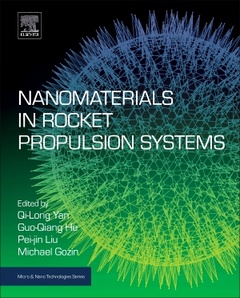Nanomaterials in Rocket Propulsion Systems Micro and Nano Technologies Series
Coordonnateurs : Yan Qi-Long, He Guo-Qiang, Liu Pei-Jin, Gozin Michael

Nanomaterials in Rocket Propulsion Systems covers the fundamentals of nanomaterials and examines a wide range of innovative applications, presenting the current state-of-the-art in the field. Opening with a chapter on nano-sized energetic materials, the book examines metal nanoparticles-based fuels, ballistic modifiers, stabilizers and catalysts as the components of rocket propellants. Hydrogen storage materials for rocket propulsion based on nanotubes are then discussed, as are nano-porous materials and metal organic frameworks, nano-gelled propellants, nano-composite ablators and ceramic nano-composites. Other applications examined include high thermal conductivity metallic nano-composite nozzle liners, nano-emitters for Coulomb propulsion of space-crafts, and highly thermostable nano-ceramics for rocket motors.
The book finishes with coverage of combustion of nano-sized rocket fuels, nano-particles and their combustion in micro- and nano-electromechanical systems (MEMS/NEMS), plasma propulsion and nano-scale physics. Users will find this to be a valuable resource for academic and government institutions, professionals, new researchers and graduate students working in the application of nanomaterials in the aerospace industry.
Academic and government institutions, professionals, new researchers and graduate students working in the application of nanomaterials in aerospace industry
Guo-Qiang He is a Professor at Northwestern Polytechnical University, Xi-an, China, and Director of the Shaanxi Institute of Aeronautics. He is a member of the academic committee of the Chinese Hypersonic Technology Research and Development Center, and his research interests are aerospace propulsion applications, including rocket engine technology.
Pei-Jin Liu is Professor and Vice-Dean of the School of Astronautics at Northwestern Polytechnical University, Xi-an, China. He has published two books on astronautic propulsion and combustion and conducts research on rocket propulsion, combustion diagnostics and instability.
Michael Gozin is Associate Professor of Chemistry at Tel Aviv University, Israel. His research activity focuses on the preparation and characterization of novel nitrogen-rich materials for fire-extinguishing and other applications, preparation of new materials for therapy and biomedical imaging, and development of new chemosensors for forensic and other applications.
- Provides a detailed overview of different types of nanomaterials used in rocket propulsion, highlighting different situations in which different materials are used
- Demonstrates the use of new nanomaterial concepts, allowing for an increase in payload capacity or a decrease in launch mass
- Explores a range of applications using metal nanopowders, presenting a panorama on cutting-edge, technological developments
Date de parution : 10-2018
Ouvrage de 592 p.
19x23.3 cm
Thèmes de Nanomaterials in Rocket Propulsion Systems :
Mots-clés :
2D energetic materials; 3D printing; Ablatives; Al/CuO/NC; Aluminum powders; Ammonium perchlorate; AP-based composite propellants; Ballistic properties; Bottom-up approach; Burn rate; Burning rate; Caoting/substrate interface; Carbon nanotubes; Carbon/carbon composites; Carr index; CNT-C/C composites; Combustion catalysis; Combustion catalysts; Combustion performance; Combustion; Composite propellant; Composite solid propellant; Detonation; Double-base propellant; Energetic application; Energetic materials; Explosive; Explosives; Ferrocene-grafted HTPB; Fiber/matrix interface; Graphene; Hausner ratio; Hazardous properties; High char yield thermosets; HTPB; Insensitive; Kinetics; Material chemistry; Metallo-polyurethanes; Micropropulsion systems; Microthruster; Microthrusters; MOFs; Nanoaluminum; Nano-cocrystals; Nanoenergetic material; Nanoenergetic materials; Nanoexplosives; Nanometals; Nanoparticles; Nanosized metal particles; Nanostructured; Nanothermite; Oxidation; Oxy-acetylene torch; Performance; Polymer nanocomposites; Polymeric ablative materials
